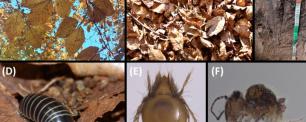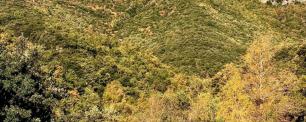FORESTSOILORG
Soil organisms enhance stability as disturbed forests regrow in a warming world?
Forests are home to a large part of the terrestrial biodiversity on Earth, and this biodiversity sustains critical ecosystem processes, including climate regulation, and carbon (C) and nutrient cycling. The sustaining of these ecosystem functions depends not only on the aboveground biodiversity, but also on the extremely complex and diverse belowground communities of microbial and invertebrate organisms. These soil organisms are intimately linked to tree species such that their interactions underpin importantly plant litter decomposition and soil organic matter formation and, therefore, the accumulation of C belowground. Considering that soils store the majority of the C in the terrestrial biosphere, anthropogenic disruptions in the interaction between trees and soil organisms could alter the global C cycle, increasing atmospheric CO2 and consequently the magnitude of climate change. In contrast, if these interactions remain strong and support ecosystem C storage, they might partly compensate for C emissions from human activity, slowing the rate of climate change and providing ecosystems, and humans, with more time for adaptation. Thus, a better understanding of the regulatory functions of soil organisms is essential in safeguarding the functioning of forest ecosystems and in the mitigation of climate change.
The critical role of soil organisms and forest ecosystems as C sinks is under risk from the intensification of land-use change, a severe and widespread driver of forest degradation and loss. However, while deforestation and logging continue in tropical and boreal regions, in temperate latitudes of the northern hemisphere secondary forests are rapidly increasing through natural re-colonisation as unprofitable agricultural and pasture lands are abandoned. Secondary forests might constitute a large component of C uptake from the atmosphere, but climate change-type drought limits this C sink capacity. The impacts of increased drought on forest ecosystems are particularly uncertain in the Mediterranean basin because this geographical region has experienced a widespread expansion of secondary forests but, at the same time, it also represents the driest distribution edge of keystone tree species. Whilst it is increasingly recognized that the legacies of past land use (e.g., altered soil fertility) can play a major role in tree responses to climate change, their effects on the interactions between soil organisms and trees, that underpin feedbacks to ecosystem functioning, are largely unknown.
Objectius
By coupling a field study with molecular tools, this project will examine the contribution of soil organisms to the ecosystem C and nutrient balance in a context of climate and land use change at the driest distribution edge of the keystone tree species Fagus sylvatica.
By focusing on the role of soil invertebrate fauna relative to soil microorganisms (fungi and bacteria) across contrasting contexts of drought stress and land-use legacies, the project will address two major objectives: (1) to determine the relative contribution of microorganisms and invertebrates to soil organic matter decomposition and formation, and (2) to determine how the soil food web structure influences the magnitude of soil C stocks, focusing on hyper-diverse groups of arthropods. This project will provide key insight on the importance of preserving soil biodiversity and function in forest ecosystems.
External team members
Photo credits
1. (A) Beech leaves in autumn. Photographer: Albert Vilà Cabrera. (B) Beech leaf litter. Photographer: Albert Vilà Cabrera. (C) Vertical soil profile. Photographer: Xavier Domene. (D) Millipede Glomeris marginata. Photographer: François-Xavier Joly. (E) Mite. Photographer: Irene Santos Perdomo. (F) Collembola. Photographer: Nira Vega Pita
2. Area of transition between Mediterranean forest (holm oak and oak) and temperate beech forest. Photographer: Albert Vilà Cabrera
3. Foggy environment in one of our study sites (beech forest). Photographer: Sofia Nieto Salas







